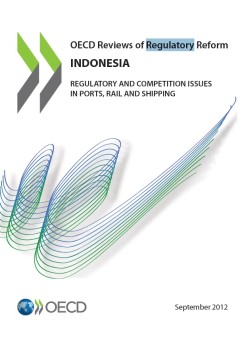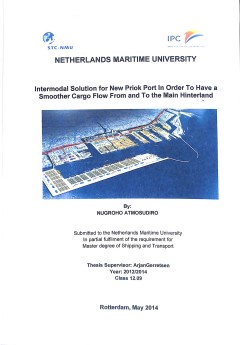Ditapis dengan

The Study on the Master Plan of Container Cargo Handoling Ports, Dry Ports an…
- Edisi
- -
- ISBN/ISSN
- -
- Deskripsi Fisik
- -
- Judul Seri
- -
- No. Panggil
- SC TXT THE m
- Edisi
- -
- ISBN/ISSN
- -
- Deskripsi Fisik
- -
- Judul Seri
- -
- No. Panggil
- SC TXT THE m

Scheduling operations of a rail crane and container deliveries between rail a…
This article addresses the problem of scheduling container transfer operations in rail terminals. The overall problem can be divided into three smaller problems: constructing a dual-cycle delivery task by matching inbound and outbound containers; determining parking positions for trucks; and sequencing the delivery tasks for transfer by the rail crane. This article provides a mathematical model…
- Edisi
- Vol. 43, No. 6, June 2011, 597–613
- ISBN/ISSN
- 1029-0273
- Deskripsi Fisik
- 18 p.
- Judul Seri
- Engineering Optimization
- No. Panggil
- ATC LO JEO s

Optimal pricing and terminal location for a rail–truck intermodal service �…
To be competitive with other modes of transport, railways need to be cost-effective. In order to become more competitive in the logistics sector, Indian Railways has taken new initiatives to improve their operations in recent years. A rail–truck intermodal transportation service for Indian Railways is described in this paper. The main focus of the research presented in this paper is on the jo…
- Edisi
- Vol. 14, No. 5, October 2011, 335–349
- ISBN/ISSN
- 1469-848X
- Deskripsi Fisik
- 17 p.
- Judul Seri
- International Journal of Logistics Research and Applications: A Leading Journal of Supply Chain Management
- No. Panggil
- ATC LO DAN o

Intermodal Rail Freight in Britain: A Terminal Problem?
Rail has increased its share of the British freight market in the past decade. One particular growth market has been intermodal traffic, where consignments are carried in unit loads (i.e. containers and swap bodies): these accounted for one-fifth of rail freight volumes in 2006/07. In this paper, the key trends are identified, considering both port and domestic services. A critical component of…
- Edisi
- Vol. 23, No. 3, pp. 441–460, August 2008
- ISBN/ISSN
- 1360-0583
- Deskripsi Fisik
- 21 p.
- Judul Seri
- Planning Practice & Research
- No. Panggil
- ATC LO WOO i

Integrating intermodal transport with logistics: a case study of the UK retai…
Retail traffic is one of the main drivers for the growth of intermodal transport services in the UK. This paper examines the key factors underpinning this modal shift in order to learn lessons for other market and geographical contexts. Since successful retail intermodal logistics involves many actors, this paper is based on semi-structured interviews with major UK retailers, third-party logist…
- Edisi
- Vol. 38, No. 3, 347–374
- ISBN/ISSN
- -
- Deskripsi Fisik
- 29 p.
- Judul Seri
- Integrating intermodal transport with logistics
- No. Panggil
- ATC LO MON i

Injury Outcome in Crashes with Guardrail EndTerminals
The goal of this study is to evaluate the crash performance of guardrail end terminals in real-world crashes. Guardrail end terminals are installed at the ends of guardrail systems to prevent the rail from spearing through the car in an end-on collision. Recently, there has been a great deal of controversy as to the safety of certain widely used end terminal designs, partly because there is sur…
- Edisi
- 2015
- ISBN/ISSN
- 1538-957X
- Deskripsi Fisik
- 7 p.
- Judul Seri
- Traffic Injury Prevention
- No. Panggil
- ATC LO JOH i

Gantry Crane Scheduling with Interference Constraints in Railway Container Te…
Railway container terminals, where gantry cranes are responsible for loading and unloading containers between freight trains and yards, are important hubs of hinterland logistics transportation. Terminal managers confront the challenge in improving the efficiency of their service. As the most expensive equipment in a terminal, the operational performance of gantry cranes is a crucial factor. In…
- Edisi
- Vol. 6, No. 2 (March, 2013), 244-260
- ISBN/ISSN
- -
- Deskripsi Fisik
- 18 p.
- Judul Seri
- International Journal of Computational Intelligence Systems
- No. Panggil
- ATC LO GUO g

Automated shunting of rail container wagons in ports and terminal areas
The development of intermodal container transport is hampered in part by the cost associated with the shunting of trains in marshalling yards, inland and port railway terminals. Many new technologies have been developed in the past decade, but have still not been applied because of high capital investment costs, lack of sufficient market demand and uncertain rates of return. The key for increas…
- Edisi
- Vol. 27, No. 5, pp. 385–401
- ISBN/ISSN
- 1029-0354
- Deskripsi Fisik
- 19 p.
- Judul Seri
- Transportation Planning and Technology
- No. Panggil
- ATC LO HAN a

Factors influencing implementation of a dry port
A close dry port with direct rail connection to a seaport is a potential solution for seaport terminal congestion as well as for better seaport inland access. The purpose of this paper is to investigate and define impediments to a close advanced intermodal terminal – dry port implementation.
- Edisi
- Vol. 38 No. 10, 2008 pp. 782-798
- ISBN/ISSN
- 0960-0035
- Deskripsi Fisik
- 17P
- Judul Seri
- Factors influencing implementation of a dry port
- No. Panggil
- ATC PO ROS f

Optimising Container Transfers at Multimodal Terminals
The use of containers have greatly reduced handling operations at ports and at all other transfer points, thus increasing the efficiency and speed of transportation. This was done in an attempt to cut down the cost of maritime transport, mainly by reducing cargo handling and costs, and ships’ time in port by speeding up handling operations. This paper discusses the major factors influencing …
- Edisi
- -
- ISBN/ISSN
- 0895-7177
- Deskripsi Fisik
- 9 p.
- Judul Seri
- Mathematical and Computer Modelling
- No. Panggil
- ATC PO ZAN o

Border-crossing constraints, railways and transit transports in Estonia
North-East Europe has served as a general cargo transit area for Russia and other emerging economies of the East for decades. Typically, this activity was initiated with road transport, but after some years of operation, bordercrossings became problematic and in some cases even impossible to conduct. Volume of transit transport was therefore severely constrained. As one remedy to sustain transi…
- Edisi
- -
- ISBN/ISSN
- 2210-5395
- Deskripsi Fisik
- 8 p.
- Judul Seri
- Research in Transportation Business & Management
- No. Panggil
- ATC PO OLA b

OECD reviews of regulatory reform Indonesia, regulatory and competition issue…
- Edisi
- -
- ISBN/ISSN
- -
- Deskripsi Fisik
- 47 p.
- Judul Seri
- -
- No. Panggil
- TXT PO OEC o
- Edisi
- -
- ISBN/ISSN
- -
- Deskripsi Fisik
- 47 p.
- Judul Seri
- -
- No. Panggil
- TXT PO OEC o

An industry analysis of express freight from a European railway perspective
There are large differences in both speed and costs between the traffic modes road and air. Rail has not yet successfully offered services “faster than road but cheaper than air”, although there are technical, logistical and economical opportunities for competing with air for intra-continental shipments and co-operate for intercontinental ones. The article categorises segments of the Europe…
- Edisi
- Vol. 33 No. 8, 2003
- ISBN/ISSN
- -
- Deskripsi Fisik
- 19 p.
- Judul Seri
- International Journal of Physical Distribution & Logistics Management
- No. Panggil
- ATC LO WOX a

Development of seaport–dry port dyads : two cases from Northern Europe
An increase in sea freight flows generates an almost proportional increase in inland freight flows, and what takes place inland will influence the ability of intermodal transport systems to further accommodate the growth of international trade. This could be facilitated by dry ports, which have been developed to support seaport operations as well as the overall operations of intermodal trans…
- Edisi
- -
- ISBN/ISSN
- -
- Deskripsi Fisik
- 11 p.
- Judul Seri
- Journal of Transport Geography
- No. Panggil
- ATC PO BAS d

ICT for cooperative supply chain visibility within a port centric intermodal …
Although ICT applications in transport and logistics have gone a long way especially in the past decade, supply chain visibility still remains a challenging issue to be tackled. This is especially important in the case of a Med port-rail-dryport setting, as the FutureMed project testifies. Cooperative action of the supply chain actors involved in such a setting is required to solve the informat…
- Edisi
- Vol. 2, No. 1
- ISBN/ISSN
- 2287-108
- Deskripsi Fisik
- 11 p.
- Judul Seri
- International Journal of Advanced Logistics
- No. Panggil
- ATC PO ELI i

Optimisation of railway terminal design and operations using villon generic s…
Railway service terminals (nodes) are the places of a railway network equipped with costly technology based on high complexity technological procedures demanding a high degree of coordination and control skills. Great effort is therefore exerted to find an optimal configuration of infrastructure to extensively exploit technical and human resources and to effectively organize technological proce…
- Edisi
- 23
- ISBN/ISSN
- 1648-3480
- Deskripsi Fisik
- 7 pages
- Judul Seri
- Transport
- No. Panggil
- ATC PO ADA o

Factors influencing implementation of a dry port
Purpose – A close dry port with direct rail connection to a seaport is a potential solution for seaport terminal congestion as well as for better seaport inland access. The purpose of this paper is to investigate and define impediments to a close advanced intermodal terminal – dry port implementation. Design/methodology/approach – Comparative case studies through face-to-face interviews a…
- Edisi
- Vol. 38
- ISBN/ISSN
- 0960-0035
- Deskripsi Fisik
- 19 pages
- Judul Seri
- International Journal of Physical Distribution & Logistics Management
- No. Panggil
- ATC PO ROS f

Factors influencing implementation of a dry port
A close dry port with direct rail connection to a seaport is a potential solution for seaport terminal congestion as well as for better seaport inland access. The purpose of this paper is to investigate and define impediments to a close advanced intermodal terminal – dry port implementation.
- Edisi
- Vol. 38 No. 10, 2008 pp. 782-798
- ISBN/ISSN
- -
- Deskripsi Fisik
- 19 p.
- Judul Seri
- International Journal of Physical Distribution & Logistics Management
- No. Panggil
- ATC LO ROS f

Modal shift for greener logistics – the shipper’s perspective
A commonly suggested measure to make logistics greener is a shift to intermodal road-rail transportation. Most research addresses the issue from the carrier’s perspective, arguing for ways to improve the service production to better fit the shippers’ demand. In this article the issue is addressed from the shipper’s perspective. The purpose is to understand what contextual factors and oper…
- Edisi
- Vol. 42 No. 1, 2012 pp. 36-59
- ISBN/ISSN
- -
- Deskripsi Fisik
- 27 p.
- Judul Seri
- International Journal of Physical Distribution & Logistics Management
- No. Panggil
- ATC LO KOH m

Benchmarking the performance indicators of Indian Railway container business …
Indian Railways being sole government organization for infrastructure, operations and regulatory functions entered for competition in the container segment in January 2006 through private-public participation for customer-centric competitiveness to break monopolistic control of Container Corporation of India (CONCOR) introducing limited licensing policy. The purpose of this research work is to …
- Edisi
- Vol. 21 No. 1, 2014
- ISBN/ISSN
- -
- Deskripsi Fisik
- 22 p.
- Judul Seri
- Benchmarking: An International Journal
- No. Panggil
- ATC LO BHA b

Intermodal Solution for New Priok Port In Order To Have a Smoother Cargo Flow…
Over the years, Port of TanjungPriok is the main National hub port in Indonesia that gives major contributions and is energizing the regional and national economy. Synergizing with the improvement of national economy, Port of TanjungPriok is also experiencing a staggering container throughput increases especially in the last five years, that resulted in the existing capacity strug…
- Edisi
- -
- ISBN/ISSN
- -
- Deskripsi Fisik
- ix, 63 p., : illus : table : 30 cm
- Judul Seri
- -
- No. Panggil
- TD PO ATM i
 Karya Umum
Karya Umum  Filsafat
Filsafat  Agama
Agama  Ilmu-ilmu Sosial
Ilmu-ilmu Sosial  Bahasa
Bahasa  Ilmu-ilmu Murni
Ilmu-ilmu Murni  Ilmu-ilmu Terapan
Ilmu-ilmu Terapan  Kesenian, Hiburan, dan Olahraga
Kesenian, Hiburan, dan Olahraga  Kesusastraan
Kesusastraan  Geografi dan Sejarah
Geografi dan Sejarah